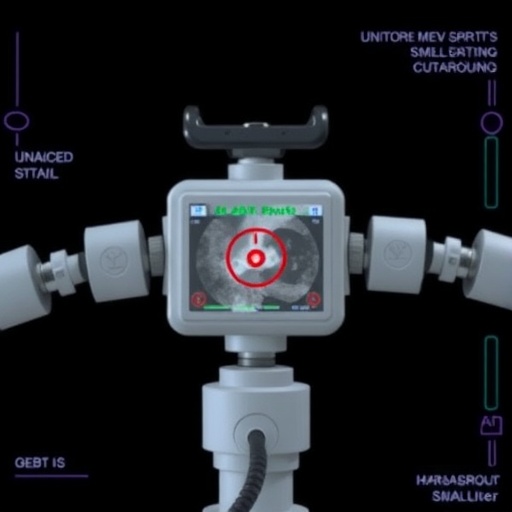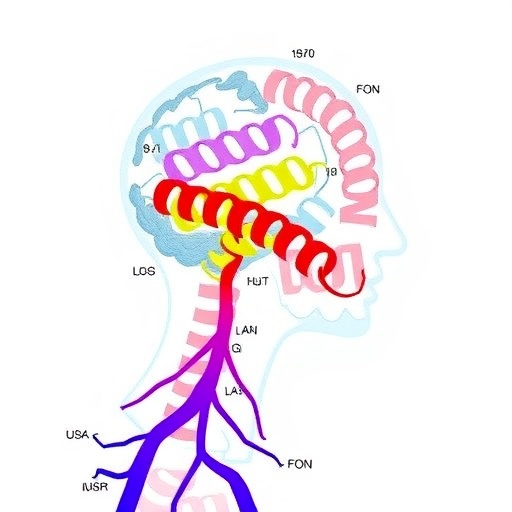In a pioneering development poised to reshape the future of medical imaging, researchers have unveiled a sophisticated autonomous robotic system that performs expert-level carotid ultrasonography. This breakthrough, detailed in a recent publication in Nature Communications, leverages large-scale learning-based algorithms to enable a robotic platform capable of conducting carotid ultrasound scans with precision and consistency that rivals experienced human sonographers. The novel system represents a critical step toward the integration of artificial intelligence and robotics in routine clinical diagnostics, promising enhanced accuracy, reduced operator dependency, and expanded access to vascular health assessment worldwide.
Carotid ultrasonography is a widely employed imaging technique for diagnosing vascular diseases, particularly carotid artery stenosis, which is a major risk factor for ischemic stroke. Traditionally, conducting such scans requires extensive manual expertise to maneuver the ultrasound probe accurately along the neck’s anatomy and to obtain interpretable images. This dependency on highly skilled clinicians poses challenges in standardization and limits accessibility in under-resourced regions. The advent of an autonomous robotic system dedicated to this task could democratize vascular diagnostics by delivering uniform and repeatable assessment irrespective of local human expertise.
The research team developed a multi-modal robotic system embedded with advanced visual perception and tactile sensing capabilities, allowing it to interact with the patient’s anatomy in a delicate yet controlled manner. At the heart of the system lies a large-scale learning framework trained on thousands of carotid ultrasound images annotated by expert clinicians. This extensive dataset empowers the robotic platform to identify and adapt to anatomical variations while accurately positioning the ultrasound probe to capture diagnostically relevant cross-sections of the carotid artery.
.adsslot_zisGv2FAuf{ width:728px !important; height:90px !important; }
@media (max-width:1199px) { .adsslot_zisGv2FAuf{ width:468px !important; height:60px !important; } }
@media (max-width:767px) { .adsslot_zisGv2FAuf{ width:320px !important; height:50px !important; } }
ADVERTISEMENT
A pivotal challenge addressed by the team was endowing the robot with real-time feedback mechanisms that ensure safe probe contact pressure and optimal image acquisition angles. Traditional robotic systems often struggle with the compliant and dynamic nature of human tissue, but this approach integrates sensor fusion techniques that interpret tactile data alongside visual cues. The fusion enables continuous adjustments to the probe’s position and pressure, emulating the manual finesse of seasoned sonographers during scanning procedures.
The learning-based controller operates through a multi-stage architecture. Initially, a perception module employs convolutional neural networks (CNNs) to analyze ultrasound frames, detecting critical anatomical landmarks and assessing image quality metrics. Successively, a reinforcement learning component guides the probe manipulator’s trajectory, maximizing the likelihood of acquiring high-quality diagnostic images. This closed-loop system continuously learns from ongoing scans, refining its strategy through trial and error under supervised conditions during preclinical validation phases.
Experimental evaluation conducted on a sizeable cohort of volunteers demonstrated remarkable performance. The robot achieved imaging metrics comparable to human experts in terms of image clarity, vessel boundary delineation, and diagnostic feature identification. Intriguingly, the system exhibited superior consistency, eliminating the variability commonly observed between different operators. Not only did this suggest improved diagnostic reliability, but it also underscored the potential to reduce interpretative errors linked to suboptimal image acquisition.
Beyond image acquisition, the platform is designed to seamlessly integrate with automated image analysis tools. This end-to-end pipeline facilitates rapid identification of carotid plaques, measurement of intima-media thickness, and characterization of stenotic lesions. Such comprehensive automation can accelerate clinical decision-making workflows, enabling timely interventions for patients at elevated risk of cerebrovascular events.
The broader implications of this work position robotic ultrasonography as a formidable asset in telemedicine and decentralized healthcare delivery. In remote or underserved areas lacking specialist expertise, the system could operate with minimal supervision, transmitting high-fidelity diagnostic data to off-site clinicians or AI-driven diagnostic support systems. Consequently, this innovation holds promise in bridging healthcare disparities, particularly in stroke prevention strategies where early vascular assessment is crucial.
From a technological perspective, the convergence of robotics, AI-driven perception, and real-time adaptive control exemplifies the next frontier in medical device engineering. The researchers navigated challenges inherent to biological variability, soft tissue deformation, and the need for gentle yet precise manipulation—obstacles that have historically limited robotic applications in sensitive clinical domains. Their solution represents a milestone in human-robot interaction by balancing autonomy with rigorous safety requirements.
Furthermore, the large-scale dataset curated for this study constitutes a significant resource for the broader scientific community. It captures a diverse spectrum of carotid anatomical presentations and pathological variations, supporting future research in AI-driven vascular imaging and diagnosis. By publicly sharing portions of this repository, the investigators encourage collaborative efforts towards standardizing carotid ultrasound protocols and advancing intelligent imaging technologies.
Critically, the system’s real-time performance has been finely tuned to fit within clinical time constraints. Rapid scan execution without compromising accuracy is vital for patient throughput in busy healthcare settings. This balance between speed and precision enhances the feasibility of deploying autonomous ultrasound robots alongside human practitioners as complementary diagnostic tools.
Looking ahead, the team envisions expanding this autonomous ultrasonography framework to additional vascular territories and anatomical sites, including peripheral arteries and cardiac imaging windows. Incorporating multi-modal imaging sensors and further improving artificial tactile perception remain key goals to enhance versatility and robustness. The development of intuitive user interfaces will also be essential to facilitate operator oversight and customization during clinical deployment.
Ethical and regulatory considerations are integral components of translating such cutting-edge robotics into everyday clinical practice. Ensuring patient safety, data privacy, and adherence to medical device standards underpins ongoing efforts to validate and certify the system in extended clinical trials. Stakeholder engagement with clinicians, patients, and regulatory bodies will shape the pathway to widespread adoption of autonomous ultrasonography technologies.
In addition to its clinical promise, this research exemplifies a paradigm shift toward autonomous systems that integrate deep learning with physical interaction capabilities. The blend of perception, control, and learning embodied in this work highlights the transformative potential of AI-enhanced robotics to automate complex sensorimotor tasks traditionally delegated to human experts. Such developments resonate across multiple domains, hinting at future scenarios where machines assume greater roles in patient care delivery.
In sum, the reported autonomous carotid ultrasonography system stands as a landmark achievement in medical robotics and artificial intelligence. Its capacity to replicate and potentially surpass human-level expertise in a critical diagnostic procedure heralds a new era of precision medicine augmented by intelligent machines. As this technology progresses from research prototypes to clinical tools, it promises to enhance diagnostic accuracy, streamline workflows, and democratize access to life-saving vascular health assessments worldwide.
Subject of Research: Autonomous robotic system for expert-level carotid ultrasonography leveraging large-scale learning-based algorithms and sensor fusion techniques.
Article Title: Towards expert-level autonomous carotid ultrasonography with large-scale learning-based robotic system.
Article References:
Jiang, H., Zhao, A., Yang, Q. et al. Towards expert-level autonomous carotid ultrasonography with large-scale learning-based robotic system. Nat Commun 16, 7893 (2025). https://doi.org/10.1038/s41467-025-62865-w
Image Credits: AI Generated
Tags: artificial intelligence in medical diagnosticsautonomous carotid ultrasound roboticscarotid artery stenosis detectionclinical applications of robotics in medicinedemocratizing vascular health assessmentenhancing accuracy in carotid ultrasonographyexpert-level ultrasound imagingmachine learning in ultrasoundprecision medical imaging advancementsreducing operator dependency in diagnosticsrobotic systems in healthcarevascular disease diagnosis technology





